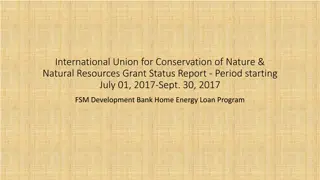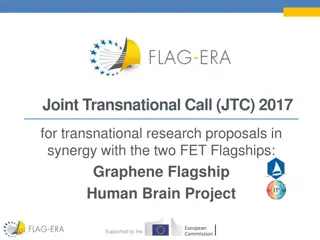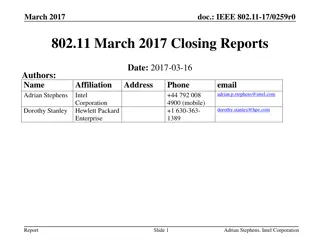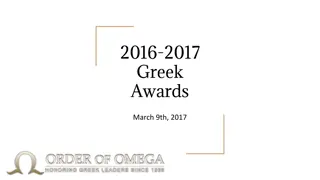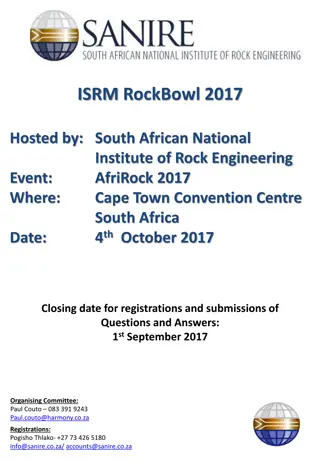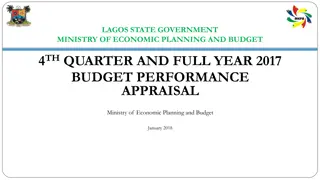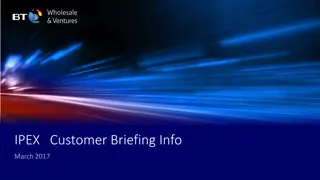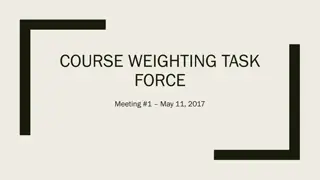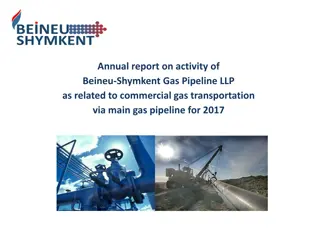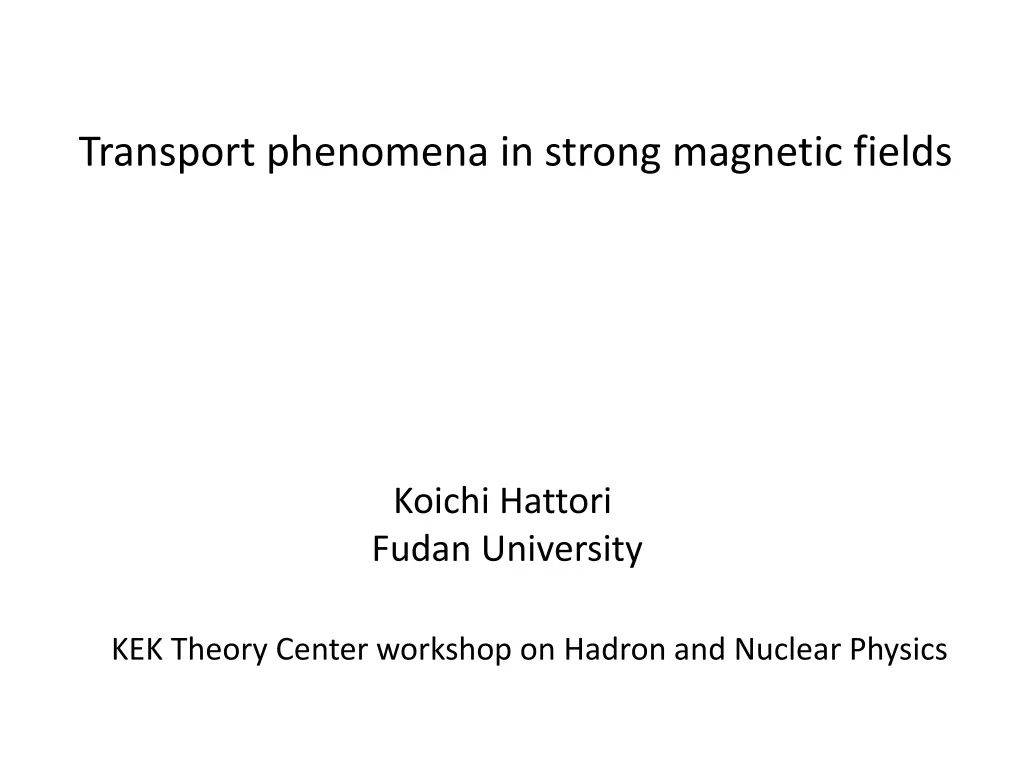
Exploring Transport Phenomena in Strong Magnetic Fields in Hadron and Nuclear Physics Workshop
Discover the impact of strong magnetic fields induced by heavy-ion collisions, Heavy Quark Dynamics in Quark-Gluon Plasma, and perturbative computations in momentum diffusion constant. Explore theoretical models and effects of strong magnetic fields on thermal quarks and gluons. Dive into the dynamics of Heavy Quark in the Quark-Gluon Plasma and understand the modifications in dispersion relations and Debye screening mass. Learn about the Perturbative Computation of Momentum Diffusion and schematic pictures in the strong field limit. Delve into Fermions in 1+1 dimensions and the Gluon self-energy in the Schwinger model.
Download Presentation

Please find below an Image/Link to download the presentation.
The content on the website is provided AS IS for your information and personal use only. It may not be sold, licensed, or shared on other websites without obtaining consent from the author. If you encounter any issues during the download, it is possible that the publisher has removed the file from their server.
You are allowed to download the files provided on this website for personal or commercial use, subject to the condition that they are used lawfully. All files are the property of their respective owners.
The content on the website is provided AS IS for your information and personal use only. It may not be sold, licensed, or shared on other websites without obtaining consent from the author.
E N D
Presentation Transcript
Transport phenomena in strong magnetic fields Koichi Hattori Fudan University KEK Theory Center workshop on Hadron and Nuclear Physics
Strong magnetic field induce by heavy-ion collisions Impact parameter Deng & Huang (2012), KH, & Huang (2016)
1. Heavy Quark Diffusion Dynamics in QGP K. Fukushima (Tokyo), KH, H.-U. Yee (UIC), Yi Yin (BNL MIT), Phys. Rev. D 93 (2016) 074028. arXiv:1512.03689 [hep-ph] Cf.) KH and Xu-Guang Huang, arXiv:1609.00747 [nucl-th] 2. Ohmic conductivity in QGP KH, Shiyong Li (UIC), Daisuke Satow (Frankfurt), Ho-Ung Yee, arXiv:1610.06839 [hep-ph] KH and Daisuke Satow, Phys. Rev. D 94 (2016). arXiv:1610.06818 [hep-ph] 3. Novel anomalous transport from magneto-vorticity coupling KH and Yi Yin, Phys. Rev. Lett. 117 (2016) 15, arXiv:1607.01513 [hep-th]
1. Heavy quark as a probe of QGP g g Thermal Quark-Gluon Plasma (QGP) Hadrons RHIC Non-thermal heavy-quark production in hard scatterings Momentum distribution of HQs in log scale Initial distribution ( = 0) from pQCD LHC Thermal ( = ) Relaxation time is controlled by transport coefficients (Drag force, diffusion constant)
Heavy quark (HQ) dynamics in the QPG -- In soft regime Langevin equation Random kick (white noise) Einstein relation Drag force coefficient: D Diffusion constant: Perturbative calculation by finite-T field theory (Hard Thermal Loop resummation) LO and NLO without B are known (Moore & Teaney, Caron-Huot & Moore).
Perturbative computation of momentum diffusion constant Momentum transfer rate in the LO Coulomb scatterings 2 2 2 2 + + HQ HQ HQ HQ Thermal quarks Thermal quarks Thermal gluons Thermal gluons c.f.) LO and NLO without B (Moore & Teaney, Caron-Huot & Moore) Effects of a strong magnetic field (eB >> T^2) 1. Modification of the dispersion relation of thermal quarks 2. Modification of the Debye screening mass
Schematic picture in the strong field limit Wave function Fermions in 1+1 dimension Gluon self-energy Schwinger model Strong B + There is no T or correction in massless Schwinger model + Mass correction is small ~ m/T
Prohibition of the longitudinal momentum transfer Massless limit Linear dispersion relation Spatial momentum transfers in the direction of B From the chirality conservation Static limit (or HQ limit) HQ Light quark
Transverse diffusion constant in massless limit Distribution of the quark scatterers Screened Coulomb scattering amplitude (squared) Spectral density
Longitudinal diffusion constant 1. Current quark mass correction 2. Gluon contribution Same as Moore & Teaney up to constants Comparison between two contributions
Anisotropic momentum diffusion constant Remember the density of states in B-field. In strong field limit, Cf. Computation by strong-coupling theory S. Finazzo, R. Critelli, R. Rougemont, J. Noronha, arXiv:1605.06061
Implication for v2 of heavy flavors Magnetic anisotropy gives rise to v2 of HQs even without v2 of medium. Possible to generate v2 of HQs in the early QGP stage.
Longitudinal conductivity in the strong B Current only in z direction Boltzmann eq. Total current integrated over pz
How linearized Boltzmann eq. works LHS Stationary and homogeneous limit Driving term due to the external electric field RHS Collision term: e.g., relaxation time approximation Linearized Boltzmann eq. Solution
Collision term from microscopic theory Perturbation theory Finite B opens 1-2 processes
Chirality selection in the massless limit Energy-momentum conservation in 2D RH antiparticle RH particle RH particle RH particle Gluon emission in a collinear configuration Transverse gluons
Results + Density of states + Chirality conservation in 1-2 (2-1) processes + IR cutoff No need to Iterate Boltzmann eq. Transition from strong B (LLL) to weak B (Effects of hLL).
Consistent result from diagrammatic calculation KH, D. Satow Response function Kubo formula Divergence in free theory No need to resum the pinch singularity in the present case + + +
3. Anomaly-induced transport from magneto-vorticity coupling Chiral magnetic effect: Chiral vortical effect: Coefficients are time-reversal even. Non-dissipative transport phenomena is due to topology in quantum anomaly and is nonrenormalizable. Anomaly coefficient
Consistent predictions from fundamental and effective theories Anomalous hydrodynamics due to Son and Surowka QFT Anomalous transport The coefficients are determined by the second law of thermodynamics. Chiral kinetic theory Q: What about the second order in the derivative expansion in a strong B and a still perturbative vorticity?
Shift of thermal distribution functions Spin-vorticity coupling Spin alignment in magnetic field for particle (upper) and antiparticle (lower). Shift if independent of the chirality (Determined only by the spin direction) Size of the spin
Field-theoretical computation by Kubo formula There is no T or correction in the massless limit! Consistent with the previous observation from the shift of distributions.
Summary We investigated non-anomalous and anomalous transport phenomena. Non-anomalous: Heavy-quark diffusion and Ohmic conductivity Anomalous: Magneto-vorticity coupling The LLL particles are chiral, and the chirality selection plays crucial roles. Outlook Computation in the weak field limit as a step toward including the time dependence of the B-field.
Causality problem: A rigid rotation of an infinite-size system breaks causality in the peripheral region. One must have a finite-size system with an exterior boundary or a local vortex field. L R Local shift of the charge density Redistribution of charge in the system







